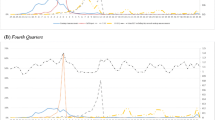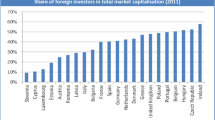Abstract
There exists a considerable debate in the literature investigating how stock market upswings or downswings impact financial market regulation. The present paper contributes to this literature and investigates whether financial market regulation follows a regulative cycle: does regulation, and consequently investor protection, increase as a result of a stock market downturn [as argued by, e.g., Zingales (J Account Res 47(2): 391–425, 2009)] or—contrary to the regulative cycle hypothesis—as a result of an upswing [as claimed by Povel et al. (Rev Financ Stud 20(4): 1219–1254, 2007), or Hertzberg 2003] Following Jackson and Roe (J Financ Econ 93(2): 207–238, 2009), we use funding data on the world’s most important financial market regulator, the U.S. Securities and Exchange Commission (SEC), as a proxy for the politically desired degree of regulation. We apply time series analysis. Using more than 60 years of data, we show that the SEC’s funding follows a regulative cycle: A weak stock market results in increased resources for the SEC. A strong stock market results in reduced resources. Our findings underline the downside of regulation as the regulative cycle amplifies the technical procyclicality inherent in regulation.



Similar content being viewed by others
Notes
Zingales (2009) is not the only paper claiming that there exists such a tendency. Rajan and Zingales (2003), Leuz and Wysocki (2008), Jackson and Roe (2009), Brunnermeier et al. (2009), Benmelech and Moskowitz (2010), Bertomeu and Magee (2011) and Wagenhofer (2011) suggest that regulation follows a cyclical pattern.
Povel et al. (2007) suggest that the incentives for firms to commit fraud are greatest in relatively good times. It is in such times that investors will rely on publicly available information, which a fraudulent firm might manipulate, to detect “bad” firms. Once times are not too good investors have stronger incentives to monitor and firms manipulating their public information are likely to be caught. However, during very good times investors will assume that a firm which, according to public data, does not perform is having a bad day. Thus, there will be no incentive to manipulate during such times.
There exists a substantial literature (e.g. Loebbecke et al. 1989; Beasley 1996; Bell and Carcello 2000) establishing that an individual firm’s financial results might impact its probability of fraudulent reporting. The relation between stock-market wide conditions and a firm’s probability to commit fraud is, however, unclear.
Bebchuk and Neeman’s (2010, p. 1110) prediction 4 states: “Investor protection will be higher in growing economies in which the value of the new capital that needs to be raised from outside investors is largely relative to the value of the capital already in the hands of existing public firms.”
Brown et al. (2013) study the impact of shareholder protection on (young) firms’ spending on research and development. Martinsson (2013) discusses how financial regulation might even impact the demand for skilled labour. In a similar manner, Peev (2015) shows that firm-level growth in transition economies is positively affected by measures of country governance.
Our results hold if we extend the series 2010. See Sect. 3.3.
Seligman (2003) provides a comprehensive review of the SEC’s history.
SEC (2001) states that during the fiscal year of 2001 it collected $2.06 bn in fees. 48 % of that sum was generated from securities registrations; 50 % came from securities transactions. The remaining 2 % were from tender offer, merger, and other items. The agency’s 2001 budget was $430 million.
Class action litigation as a rather important means of private enforcement is discussed in detail, e.g. by Ulen (2011). The more sophisticated question whether or not a “one size fits all” regulation should be uniformly applied to all equity trading platforms within a country is analyzed by Boyle and Meade (2008). In respect to the SEC as a public enforcement institution, a recent study by Lohse et al. (2014) shows that increases in the SEC’s resources improve compliance with financial market rules. Even Del Guerico et al. (Del Guercio et al. 2013) show that there is a deterrence effect associated with SEC enforcement.
The data is on fiscal year basis. Since 1976 the federal fiscal year ends in October. Prior to that, the fiscal year ended in June.
In order to avoid our results being driven by the financial crisis or the Madoff scandal, we consider only data up to 2007. We provide a robustness check for the time until 2010 in Sect. 3.2. The number of observations we use is comparable to Jackson and Roe (2009) who use, at most, 55 observations. Furthermore, the normalization procedure used in Jackson and Roe (2009) is comparable to the one employed in this paper.
Data on the number of stocks traded on the NYSE is obtained from NYSE (2009). We use the Bureau of Labor Statistic’s consumer price index (Bureau of Labour Statistics 2009) to inflate the SEC’s budget to 2007 dollars. It should be remarked that the results of our empirical analysis can also be derived independently of this normalization. We discuss this is issue in Sect. 3.2.
The intuition behind this normalization is that two firms with each $1 bn market capital are likely to create more work for the SEC than a single firm with a market capitalization of $2 bn.
We also try other indices, e.g. the SP 500. Yet, the results are not materially affected by the choice of the index.
The univariate SBC are calculated as SBC = T log(sum of squared residuals) + n log (T) where n is the number of parameters estimated and T is the number of usable observations.
Dickey-Fuller-tests indicate that sec_stocks* is stationary. The finding that sec_stocks has a unit root can be explained by a number of factors. First, a rising complexity of the firms supervised and, second, a growth of the average market capitalization of the firms traded on the NYSE.
The results are very similar if we detrend sec_budget using a second degree polynomial. Lohse et al. (2014) use this approach.
The multivariate SBC are calculated as \( SBC = T*\log \left| \varOmega \right| + k*\log T \) where T is the number of usable observations; |Ω| is the determinant of the variance/covariance matrix of the residuals; and k is the number of parameters estimated.
In this paper we follow the suggestion of Sims and Zha (1999) and obtain confidence bands by Monte Carlo integration.
ARCH stands for autoregressive conditional heteroskedasticity.
These fractiles correspond to one standard deviation. The econometrics package RATS provides a procedure for estimating error bands according to Sims and Zha (1999).
This data is from CRSP.
These results are available from the authors upon request.
References
Bank for International Settlements. (2010). Basel Committee on Banking Supervision: Basel III: A global regulatory framework for more resilient banks and banking systems. Basel: Basel Committee on Banking Supervision.
Beasley, M. S. (1996). An empirical analysis of the relation between the board of director composition and financial statement fraud. Accounting Review, 71(4), 443–465.
Bebchuk, L. A., & Neeman, Z. (2010). Investor protection and interest group politics. Review of Financial Studies, 23(3), 1089–1119.
Bell, T. B., & Carcello, J. V. (2000). A decision aid for assessing the likelihood of fraudulent financial reporting. Auditing: A Journal of Practice & Theory, 19(1), 167–182.
Benmelech, E., & Moskowitz, T. J. (2010). The political economy of financial regulation: Evidence from U.S. state usury laws in the 19th century. Journal of Finance, 65(3), 1029–1073.
Bernanke, B. S. (2009). The financial crisis and community banking, March 20, 2009, http://www.federalreserve.gov/newsevents/speech/bernanke20090320a.htm. Accessed 30 August 2013.
Bertomeu, J., & Magee, R. P. (2011). From low-quality reporting to financial crises: Politics of disclosure regulation along the economic cycle. Journal of Accounting and Economics, 52(2), 209–227.
Boyle, G., & Meade, R. (2008). Intra-country regulation of share markets: Does one size fit all? European Journal of Law and Economics, 25(2), 151–165.
Brown, J. R., Martinsson, G., & Petersen, B. C. (2013). Law, stock markets, and innovation. The Journal of Finance, 68(4), 1517–1549.
Brunnermeier, M., Crockett, A., Goodhart, C., Persaud, A. D., & Shin, H. (2009). The fundamental principles of financial regulation. Geneva Reports on the World Economy, 11, 16–48.
Bureau of Labour Statistics (2009). Consumer price index.. http://www.bls.gov/data/#prices. Accessed 30 August 2013.
Del Guercio, D., Odders-White, E., & Ready, M. (2013). The deterrence effect of sec enforcement intensity on illegal insider trading. Available at SSRN 1784528.
Dewatripont, M., & Tirole, J. (1999). Advocates. Journal of Political Economy, 107(1), 1–39.
Enders, W. (2004). Applied econometric time series (2nd ed.). Holboken: Wiley.
Hertzberg, A. (2003). Managerial Incentives, Misreporting, and the Timing of Social Learning: A Theory of Slow Booms and Rapid Recessions. Working paper, Northwestern University.
Jackson, H. E. (2013). Public enforcement: An update of literature on resource-based evidence. Unpublished Manuscript.
Jackson, H. E., & Roe, M. J. (2009). Public enforcement of securities laws: Resource-based evidence. Journal of Financial Economics, 93(2), 207–238.
Kim, I. (2008). Securities laws ‘facilitating’ private enforcement. European Journal of Law and Economics, 25(1), 17–38.
La Porta, R., Lopez-de-Silanes, F., & Shleifer, A. (2006). What works in securities laws? Journal of Finance, 61(1), 1–32.
Leuz, C., & Wysocki, P. (2008). Economic consequences of financial reporting and disclosure regulation: A review and suggestions for future research. MIT Sloan School of Management Working Paper.
Loebbecke, J. K., Eining, M. M., & Willingham, J. J. (1989). Auditors’ experience with material irregularities: Frequency, nature, and detectability. Auditing: A Journal of Practice & Theory, 9(1), 1–28.
Lohse, T., Pascalau, R., & Thomann, C. (2014). Public enforcement of securities market rules: Resource-based evidence from the Securities Exchange Commission. Journal of Economic Behavior and Organization (forthcoming). doi:10.1016/j.jebo.2014.06.010.
Martinsson, G. (2013). Financial reform, demand for skilled labor, and growth. Swedish House of Finance Research Paper No. 13-04.
NYSE (2009). Facts and Figures, NYSE Historical Statistics, http://www.nyxdata.com/nysedata/NYSE/FactsFigures/tabid/115/Default.aspx. Accessed 30 August 2013.
Peev, E. (2015) Institutions, economic liberalization and firm growth: evidence from European transition economies. European Journal of Law and Economics. doi:10.1007/s10657-014-9450-3.
Povel, P., Singh, R., & Winton, A. (2007). Boom, busts, and fraud. Review of Financial Studies, 20(4), 1219–1254.
Rajan, R. R., & Zingales, L. (2003). Saving capitalism from the capitalists. New York: Random House.
SEC (2001). Securities and Exchange Commission annual reports, www.sec.gov. Accessed 30 August 2013.
SEC (2011). Securities and Exchange Commission annual reports, www.sec.gov. Accessed 30 August 2013.
SEC (2012). Securities and Exchange Commission annual reports, www.sec.gov. Accessed 30 August 2013.
Seligman, J. (2003). The transformation of wall street (3rd ed.). New York: Aspen.
Shleifer, A. (2005). Understanding regulation. European Financial Management, 11(4), 439–451.
Sims, C. A., & Zha, T. (1999). Error bands for impulse responses. Econometrica, 67(5), 1113–1156.
Ulen, T. S. (2011). An introduction to the law and economics of class action litigation. European Journal of Law and Economics, 32(2), 185–203.
Wagenhofer, A. (2011). Towards a theory of accounting regulation: A discussion of the politics of disclosure regulation along the economic cycle. Journal of Accounting and Economics, 52(2), 228–234.
Wang, T., & Winton, A. (2012). Competition and corporate fraud waves. Unpublished Manuscript.
Wang, T., Winton, A., & Yu, X. (2010). Corporate fraud and business conditions: Evidence from IPOs. Journal of Finance, 65(6), 2255–2292.
Zingales, L. (2009). The future of securities regulation. Journal of Accounting Research, 47(2), 391–425.
Acknowledgments
The authors thank two anonymous referees, Johan Eklund, Martin Eling, Razvan Pascalau, Lars Petterson, Daniel Wiberg, participants of the workshop on Regulation, Entrepreneurship and Firm Dynamics in Stockholm, the German Finance Association meeting and seminar participants at Humboldt University Berlin, the Universities of Hannover, Potsdam, and Ulm and the Social Science Research Center Berlin (WZB) for valuable comments on earlier versions of the paper. Tim Linderkamp provided very valuable research assistance. All errors and omissions are our own.
Author information
Authors and Affiliations
Corresponding author
Rights and permissions
About this article
Cite this article
Lohse, T., Thomann, C. Are bad times good news for the Securities and Exchange Commission?. Eur J Law Econ 40, 33–47 (2015). https://doi.org/10.1007/s10657-014-9455-y
Published:
Issue Date:
DOI: https://doi.org/10.1007/s10657-014-9455-y




